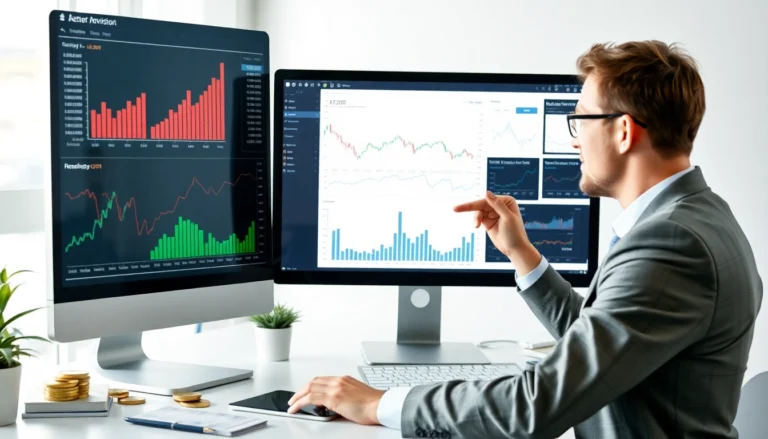Understanding the Basics of Trading View
What is Trading View and How Does It Work?
Trading view is a comprehensive charting and analysis platform designed for traders and investors across multiple asset classes including stocks, cryptocurrencies, forex, commodities, and indices. It provides real-time market data, advanced analytical tools, and social networking features that foster community engagement among traders worldwide. The platform operates primarily through a web-based interface, complemented by mobile apps available on Android and iOS, making it accessible whenever and wherever market opportunities arise.
At its core, Trading view aggregates real-time data from multiple exchanges and feeds it into customizable charts. Users can analyze price movements, apply technical indicators, and draw trendlines to identify potential entry and exit points. Its cloud-based architecture ensures that all user settings, saved layouts, and indicators are synchronized across devices. This seamless integration allows traders to switch between devices without losing progress, making Trading view a versatile tool for both beginner and advanced traders.
For those looking to deepen their market insights, Trading view also incorporates a social aspect, enabling users to publish ideas, follow other traders, and participate in community discussions. This interactive component is instrumental in learning new strategies, gaining diverse perspectives, and validating analysis through collective intelligence. To learn more about its comprehensive features, you can visit their official site trading view.
Key Features and Tools for Beginners
Trading view boasts a rich array of features tailored to meet the needs of beginner traders. One of its standout components is the intuitive charting interface, which allows users to visualize financial data through multiple chart types such as candlestick, line, and bar charts. Beginners can start with pre-configured templates or customize their workspaces to suit individual preferences.
The platform offers over 100 technical indicators and drawing tools that facilitate pattern recognition and trend analysis. For novices, a useful feature is the “Ideas” section—community-contributed trade analyses that serve as real-world examples of market behavior and technical setups. Furthermore, Trading view provides social elements like chat rooms and idea sharing, fostering peer-to-peer support.
Additional beginner-friendly tools include alerts that notify traders of price movements or indicator signals, as well as paper trading functionalities where users can simulate trades without risking real money. These features build confidence and help new traders learn their craft safely.
Setting Up Your First Chart
Getting started with Trading view involves creating a free account and customizing your workspace. Once logged in, select a chart type—candlestick is the most popular for technical analysis—and search for the trading instrument or symbol you are interested in, such as a stock ticker or cryptocurrency pair.
To set up your chart efficiently, consider adjusting the time frame (e.g., 1-minute, daily, weekly) to match your trading style. Apply relevant technical indicators like Moving Averages, RSI, or MACD to visualize trends and momentum. Use drawing tools to mark support and resistance levels, trendlines, or chart patterns like head and shoulders or double tops.
Personalize your layout by saving your settings and creating watchlists for quick access. Because the platform is highly customizable, you can add various tools and indicators to suit different strategies—whether you’re day trading, swing trading, or long-term investing.
Advanced Trading View Techniques
Using Technical Indicators Effectively
Technical indicators are vital for refining trade entries, exits, and trend confirmation. In Trading view, you can combine multiple indicators to generate robust signals. For example, moving averages can identify the trend direction, while oscillators like RSI or Stochastic can signal overbought or oversold conditions.
Effective use involves understanding the indicator’s strengths and limitations. For instance, Moving Averages work well in trending markets but may give false signals sideways. To mitigate this, traders often use a combination—say, a 50-day and 200-day SMA to identify trend shifts, complemented by MACD for momentum analysis. The platform allows setting custom indicator parameters to fine-tune signals based on your specific asset or timeframe.
Customizing Trading View for Your Trading Style
Personalization is a key advantage of Trading view. Whether you’re a scalper, day trader, or long-term investor, you can tailor the interface to optimize your workflow. Create multiple chart layouts dedicated to different strategies and save them for quick access.
Utilize scripting capabilities with Pine Script, Trading view’s proprietary programming language, to develop custom indicators, alerts, and strategies. This feature is beneficial for traders who want unique analysis tools not available as standard indicators. Additionally, setting tailored alerts based on price levels or indicator conditions keeps you informed without constantly monitoring charts.
Integrating Alerts and Automated Strategies
Alerts are instrumental for active traders. Trading view allows you to set notifications for specific conditions, e.g., when a stock crosses a moving average or an oscillator reaches an overbought level. These alerts can be delivered via email, SMS, or within the platform, helping you react promptly to market movements.
Beyond alerts, the platform supports automated trading strategies through Pine Script. Traders can backtest algorithms on historical data, optimize parameters, and deploy scripts for real-time execution when linked to brokerage accounts with supported broker integrations. This automation enhances trading efficiency and helps to execute precise strategies without emotional bias.
Optimizing Market Analysis with Trading View
Analyzing Different Asset Classes
Trading view’s versatility shines when analyzing diverse markets. Whether assessing equities, cryptocurrencies, commodities, or forex, the platform seamlessly integrates data feeds and analytical tools for all asset classes. Dedicated market views allow traders to compare multiple assets side-by-side, facilitating better portfolio diversification and risk assessment.
For example, an investor might analyze gold prices and related currency pairs simultaneously, or a crypto trader might compare Bitcoin with altcoins to spot relative strength. The ability to pull real-time data from global exchanges enables comprehensive market analysis in one unified environment.
Interpreting Price Patterns and Trends
Mastering pattern recognition is crucial in trading. Trading view provides tools to identify and interpret formations like head and shoulders, triangles, flags, and channels. Recognizing these patterns can provide early warning signs of trend reversals or continuations.
Furthermore, trend analysis—via tools like trendlines and Fibonacci retracement—helps traders gauge potential support and resistance zones. Coupling price patterns with volume analysis enhances the accuracy of predictions, making Trading view an indispensable tool for technical traders.
Utilizing Community Ideas and Shared Scripts
The social features of Trading view offer a wealth of shared analysis. Community ideas contain detailed trade setups and market commentary, often including annotated charts and explanatory notes. Engaging with these ideas can accelerate learning and inspire new strategies.
Additionally, the platform’s library of scripts—posted by users—provides custom indicators and automated tools that can be imported into your workspace. This collaborative environment fosters continuous improvement, innovation, and shared success among traders worldwide.
Best Practices and Common Challenges
Avoiding Analysis Paralysis
While Trading view’s extensive features are powerful, overloading charts with too many indicators can lead to analysis paralysis. To avoid this, adopt a disciplined approach—select only a few relevant tools for each strategy. Focus on high-probability setups and maintain a clean, interpretable chart layout.
Ensuring Data Accuracy and Security
Trustworthy data sources are essential for reliable analysis. Trading view aggregates data from reputable exchanges, but traders should verify critical trades with broker platforms. Additionally, safeguard your account credentials through strong passwords and enable two-factor authentication to protect your trading environment.
Keeping Up with Platform Updates
Trading view regularly releases updates introducing new features, indicators, and security enhancements. Staying informed about these updates ensures you leverage the latest tools and maintain optimal platform performance. Subscribe to newsletters or follow official channels to receive notifications about upcoming changes.
Performance Metrics and Success Measurement
Tracking Your Trading View Analytics
Performance tracking involves reviewing how your analysis translates into trading results. Use built-in journal features or external tracking tools to record trades triggered by your Trading view analysis. Monitor key metrics such as win rate, profit/loss ratio, and trade duration to evaluate effectiveness.
Assessing Trading Strategy Effectiveness
Backtesting with Trading view’s strategy tester allows you to simulate past trades based on your predefined rules. Analyzing backtest results provides insight into strategy robustness, slippage impact, and overall profitability. Adjust parameters accordingly to optimize success.
Continuous Learning and Platform Optimization
Market conditions evolve, and so should your analysis approach. Regularly review your charts, update indicators, and experiment with new tools or scripts. Engage with community ideas, attend webinars, and read market analyses to expand your knowledge base. Continuous learning is key to sustained trading success.

















